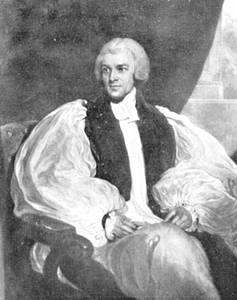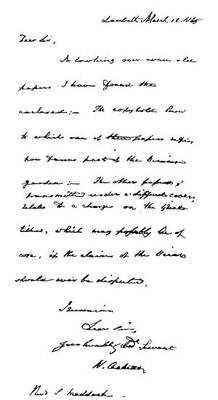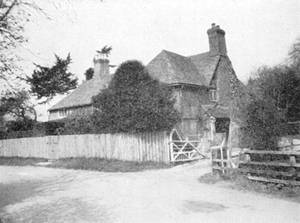The Archbishop
The last house in the village is generally called "The Archbishop's Cottage." Its roof is a thatched one and it is remarkably picturesque, and of the old-world type now rapidly disappearing. It is celebrated as having been for a while the home of William Howley, Archbishop of Canterbury, who crowned William IV. 1830, and Queen Victoria, 1837. His father was the Vicar of Ropley, and as an infant he was placed out at nurse in this cottage. Neither of its two bedrooms possessed, until quite recently, any windows at all, and were consequently in a state of total darkness ! They were approached by a rough kind of ladder.
I give an extract from "The Letters of Peter Lombard :-
"Another object of interest here (West Meon) is the marriage register of Wm. Howley, Vicar of Ropley - a village some seven miles off. Why he came here to be married I know not*, perhaps it was because his wife was below him in social position. She could not write her name, and a cross stands for her signature. They became the parents of him who was called 'the last Prince Archbishop' - a man of real dignity and of vast munificence. Merit, or good fortune or both, thus raised the son of a peasant girl to an exalted position, and he showed himself as worthy to fill it."
* Perhaps the bride's home was in West Meon ?
M.S.H.
Archbishop Howley
Autograph Letter - Archbishop Howley
The Churchyard
This has, no doubt, been used as a burying place for centuries, and in the older parts there are many old vaults, some of which were found when props were placed under the ancient yew tree on the north side of the church.
Two recent additions have been made to the Churchyard. One of these was in 1906 and the consecration was performed by Dr. Boutflower, then Bishop of Dorking. As the ground was nearly full a second addition was rendered necessary which was made in 1928. The service was conducted by the same Bishop, now of Southampton.
A note by the Vicar says :- "I should like to place on record the fact that on the two separate occasions here recorded, Miss Hagen has most generously given land for the extension of the Churchyard. At the present time (1929) there is provision for some years to come."
The Ancient Yew Tree
The ancient yew tree in the Churchyard near the south porch was formerly surrounded by a wooden seat used by the parishioners before the commencement of service. It is much decayed and the centre of the tree is a hollow shell. The branches have recently been propped so as to avoid damage from wind or snow.
Yew trees were planted in Churchyards because in olden times the Churchwardens had to supply wood for "The Bow" and the wood of the yew tree was the most suitable.
An Old Tombstone.
From Mr. Woodhouse's Note Book.
On a very old tombstone near the south porch of Ropley Church is the following inscription, illegible except in a very favourable light :
In memory of
Elizabeth Wife
Of Richard Gooder
& Daughter of
Robart Ween
Who departed
This life September
Ye 3. 1708. Aged 52.
It is seldom that one meets with a mere tombstone so old as this. The stonecutter seems to have been rather unskilled in his work, but he must have chosen a very durable stone. Inscriptions depend very much on the light and therefore on the hour of the day and the kind of weather. A slight shadow thrown by the sun at the proper angle brings out the letters.
Burials In Woollen
Memoranda occur frequently in the certificate that deceased was buried in woollen. They extend over several years in the early part of the 18th century.
I have understood that this was made compulsory in order to encourage the woollen trade.
The Old Vicarage
In the days of the Howleys this was rather smaller and more homely than it is now. It had a great stack of chimneys in the middle. The entrance projected from the front, and was approached from the road by a little straight path leading up to it by a wicket gate. A gravel path ran across, parallel with the front of the house, and extended the whole width of the garden. Where the lawn now is was thickly covered with ornamental trees, among which were a Judas tree and a fine horse chestnut. Five limes stood where one remains at the end of the house. A lane ran across between Mr. Duthy's grounds and the Vicarage garden, and continued down past "The Cottage" into the Petersfield Road. The Vicarage lane did not exist.
From Mr. Woodhouse's Note Book
The Vicarage was enlarged by the addition of a new wing, and the stables and coachhouse built by the Rev. F. H. Baring, Vicar, 1891.
I may note here that the lane running past Ropley House was moved to the left by my father. The "Old Road" track runs close by the Avenue, and was once continued close to the house.
The Old Parsonage
The Old Parsonage
"All that Decimal Grange or Parsonage House of Ropley with the tithe barn, conveyed to J. Fisher by T. Budd and R. Barker, 25th September, 1798." This is the earliest date found in the deeds relating to the house now known as the old Parsonage. The existence of the tithe barn suggests that this may formerly have been the Vicar's residence before the present Vicarage was built, though the actual evidence is not forthcoming. It was most probably called the Old Parsonage to distinguish it from the new Vicarage.


